Alan Velecky – 23h 31m 53s on the 23rd October 2010. A keen runner and well-known orienteer, Alan decided to test his legs against the SDD. With more than a year of planning behind his ride, Alan overcame a damaged tubeless tyre and cold night fog to complete the ride in 23 hours 31 minutes and 53 seconds. Apparently he timed it perfectly, with his lights going flat a minute after completing the ride.
In Alans words:
Background
I can still remember the incredulity I felt when I first heard that someone had ridden the South Downs Way twice in 24 hours. I was at my brother-in-law’s house in Norfolk in Christmas 2006. The previous year, we’d ridden the SDW together one way in a day. We’d ridden at his pace, and it had taken us 16 hours 45 minutes. It had felt like a hell of a ride. I was now surfing the web, looking for an event where I could do the route at my own pace, just to see how much faster I could do it. While searching, I came across a reference to Mike Cotty’s record breaking SDW Double (the ‘SDD’) earlier that year, and it blew my mind. I remembered how exhausted we’d felt having ridden the South Downs Way in a day in just one direction. But to then turn round and do it again? Riding in the dark? All in under 24 hours? I just couldn’t imagine it.
Fast forward to 2009. My internet searches back in 2006 had brought the BHF Randonnee event to my attention – the 100 miles from Winchester to Eastbourne, but ridden as a mass start event. I’d ridden it the previous 3 years, in 10:26, 9:15, and 9:42 (the longer bridleway route, with 2 punctures), finishing 1st rider back the last 2 years. I was aware there were people who could ride it a lot faster than me, and I didn’t think I was ever going to beat Charlie Eustace’s time of under 8 hours. So what next for me?
I am an orienteer first and foremost – that’s the sport I compete at, and I’m one of the top competitors in my age group (I’m 44) in the country. Running comes second – I run to get fit for orienteering and I do a bit of cross country and the odd marathon. Cycling is very much third – I cycle in the summer because I like it, because running in the summer gives me hayfever, and to get a break from running. I’ve got more into cycling over the last 5 years, primarily mountain biking, but in the last couple of years road cycling too, which I’ve really enjoyed. But when all’s said and done, I’m very much a casual rider – I can keep up with quite a few people who are riders first and foremost because I can draw on my general endurance fitness from running, but I’ve never raced on the bike or even trained properly for cycling.
2009 – The bug bites
So in April 2009 I’m sitting in a minibus in Spain on a mountain biking holiday with my riding and running mate Kenny Leitch. We’re talking about the South Downs Way and whether we’re both going to do the Randonnee again. The idea of the SDD comes up in conversation almost as a joke – but something clicks in my head, and for the rest of the day I’m gripped by it. We talk about how you’d do it – where you’d start from, what support you’d need, lights , kit, food. It seems an unimaginably daunting prospect, but I find it hard to dismiss the idea completely. When I get back, it’s already half-formed in my head as a goal. A few weeks later I’m chatting to a guy in the bike shop, and it turns out he’s quite clued up about it. Tells me there’s even a website, that quite a few people have done it, and that there’s this guy called Ian Leitch who’s just smashed the record. I feel a bit sick. The fact that quite a few people have done it and there’s a website somehow makes it more real and more doable. Up until that point, in my mind it was just something that one nutter had done. Finding out it’s an established endurance challenge with its own website somehow makes it harder for me to ignore. But when I look at the website, I’m not exactly encouraged. Lots of useful information about kit and routes for sure, but most of the people who’ve done it seem to be seasoned 24 hour riders, some semi-professional – no amateurs like me.
But the seed is well and truly planted. On the back of my ride in the Randonnee in late July 2009, I keep the mountain biking going with a view that I will maybe attempt the Double in early September when I get back from holiday. I do some research into lights, contact Rory Hitchens from Exposure Lights who has supported many SDD riders, and get hold of a couple of excellent MaXx Exposure lights from him that will definitely do the job. To address the puncture issue which almost torpedoed my Randonnee that year, I decide to go tubeless. I make contact with Neil Newell who has done the SDD – meeting someone who’s actually done the ride somehow makes it even more real. I do a few night rides to test out the kit. But I had a bit of a niggle in my knee on the Randonnee, and that’s still bothering me. I get back from holiday to find I’ve been selected to orienteer for England in the Veteran Home International in October. Suddenly the SDD is becoming a distraction – I should really be getting back into running training not still thinking about cycling. But I find it hard to let the SDD go – it has hold of me. Early September, and my designated day is approaching. I go out for a night ride with my knee strapped, and after only an hour it’s hurting. It’s a windy night with a chilly autumnal feel, and it somehow feels like I’ve missed the boat with the Double for the year. I think about grinding through the darkness for hour after hour on my own with a sore knee, potentially jeopardizing my England race, and I just don’t fancy it – it makes no sense. Reluctantly I let it go, and push the whole thing to the back of my mind for that year.
2010 – Will this be the year?
Fast forward again to Summer 2010. The SDD has been one of my goals for the year, but after a successful orienteering season, I’ve not felt motivated to do the long rides I would need to do in order to attempt the Double. I’ve done a few 3 hour rides, which have been plenty tough enough for me – I’ve felt pretty tired even after that amount of time in the saddle. The step up to 6 hours, 10, or even 12 seems huge; 24 out of the question. It’s looking again as though I’ve missed the SDD window.
Then I get an email from running and biking mate Dave Bradford. Do I fancy a road biking trip to the Pyrenees in early September? Of course I do! All of a sudden a plan forms in my mind. That’ll be 4 tough days in the Pyrenees. Could it also be a springboard for the SDD? Not enough, not really, but I won’t be any bike fitter this year. Or any year? Realistically, with 2 kids and a demanding job plus running always coming first, am I ever going to do the 10 / 12 / 24 hour rides that I really should to train properly for the SDD? So if not now, when?
It sounds mad to attempt a 200 mile / 24 hour ride off the back of a longest training ride of 5 hours (our longest day in the Pyrenees), but here’s my logic. Back in 1998 I rode the South Downs Way in 2 days. That felt really hard. In 2005 I rode it in 1 day in 16 hours, which I couldn’t have imagined doing in 1998. In subsequent years I shaved 6 hours, then 7 hours off that time. Unimaginable in 2005. Now I was facing the next step up – something that seemed unimaginable, but which mortals made of flesh and bone like me had done. So why couldn’t I to it too? Of course this logic must founder at some point – you can’t just keep multiplying the challenge by 2, at some point you’ll come up against your personal limits. But in the face of almost everyone I mentioned the ride to giving some variant of “you’re mad!” as a response, I needed some kind of rationale to have the confidence and belief I needed to get on my bike and even attempt the ride.
Time to commit
And so in mid-September, a window seemed to open up. The weather forecast looked good – sun, light winds, a high of 21C and a night time low of 15C with a full moon. I had a gap in my work schedule – nothing hugely demanding or stressful the few weeks afterwards if I was totally wiped out. Daylight would be against me – I’d have 10 hours in the dark compared with only 5 in mid-summer. But a look at the SDD website revealed that other people had done the ride in September. It would be cooler than summer, that at least would be in my favour.
There was a lot of psychology involved to even get myself to contemplate the ride. Thinking about doing the whole ride was almost too frightening , particularly with so little preparation. Not only had my longest ride been 5 hours, but also my total cycling mileage in the 9 months of 2010 was a meager 1300 miles, and my night mileage was zero. I couldn’t tell myself I was in great shape to do the ride, so instead I told myself I’d just set out and see how I was going, that I could always jack it in at Winchester if I was hating it and come back on the train. Somehow starting the ride part way in felt psychologically easier – the moment that terrified me was getting to Winchester having started at Eastbourne, and having to turn round and knowing I had to do all that again. But by starting at Lewes, I could get past 100 miles without being aware of it – half way would just sneak up at some anonymous point along the way. Then if I could make it back to Lewes, surely I could just keep going to Eastbourne? Then it would be home to Lewes – and having done that much, I’d surely be able to do that final 25 familiar miles – wouldn’t I? I casually mentioned that I was thinking of doing the ride to my wife, making it sound as low key as possible – and to my surprise, unlike my running and cycling mates, who had more of an idea of what was involved, she didn’t tell me I was insane to even be considering it.
So the plan formed in my mind. I’d be totally low key about it, not tell anyone I was doing it so if I got cold feet at the last minute I wouldn’t feel under pressure to do it, and could bale out with no loss of face. I’d do it unsupported, ride from home and pick up the trail at Blackcap near Lewes. It would still be a total step into the unknown with such limited training and preparation, and totally in defiance of common sense and logic, but I decided I would just do it and see what happened. 3 days before the date I’d pencilled in – 22nd September 2010 – I finally decided to do the ride.
Preparation
I hadn’t even ridden my mountain bike (a 2005 Kona Kikapu Deluxe) for two and a half months, so the first thing was to give it a clean and check it over. The gears weren’t shifting too well, and there had been an annoying front disc brake squeak for over a year – I decided both would get irritating on such a long ride, and made a last minute dash to the bike shop to get it fixed and pick up some gels and bars. My tubeless tyres had been on for over a year, so I decided to check and refresh the sealant. Neil Newell had done me a schedule the previous year for an Eastbourne start, so I dug that out, and recalculated based on my planned start from Blackcap, adding a time of day calculation assuming a 6am start. I found an elevation profile for the SDW from Antony Gray’s SDD ride in 2009, which I printed out and annotated with my schedule – now I’d know where the big hills in each section were. I taped that to my crossbar. Finally I got my kit together, made up some tuna and cheese sarnies, loaded my Camelbak – and I was all set.
Start of the ride
The big day arrived. My alarm went off at 5am. 2 large bowls of banana and raisin porridge later I was on my bike, leaving home at 5.45am, 15 minutes behind schedule. I rode the 4 miles to the start of the SDW at Blackcap going as easy as I could, paused for a minute to catch my breath, and at 6.17am, still in the dark, I hit the trail. This was it, committed, 24 hours on the bike ahead of me. It felt like a real adventure.
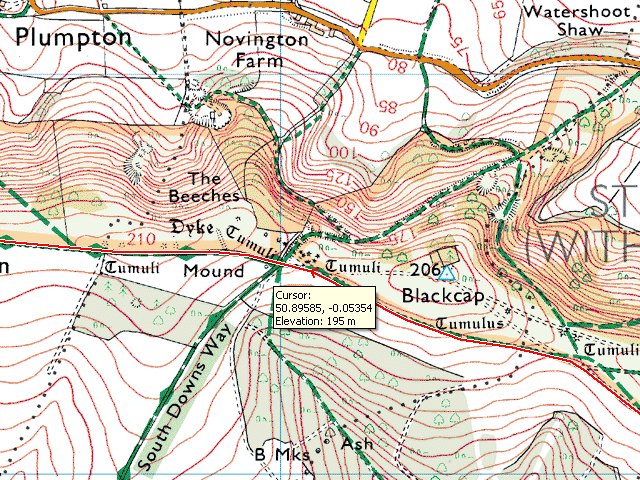
Dawn on the Downs – and some setbacks
Minutes in it started to get light, and soon I found myself riding through a perfect autumn dawn as red sunlight flooded the damp grass and illuminated a sea of mist in the valleys, out of which the Downs rose like islands. What a great way to start the ride! First few timepoints bang on schedule, the Downs to myself, feeling good! But an hour in, on the descent just before Truleigh Hill, the rear end of the bike started feeling soft and sketchy. I braked, felt down, and touched sponginess. I got off with a sickening feeling, took a closer look, and noticed sealant seeping out round the rim. All of a sudden my euphoria was gone. My preparation for the ride had hardly been meticulous – refitting my tyres the previous day without any kind of test ride – had I just not got the seal right? Trying not to panic, I got my pump out and started pumping – maybe I could just reseal it? But the tyre stayed soft, and I realised with a sinking feeling that I was going to lose some serious time here – the tyre was going to have to come off, and I was going to have to do the rest of the ride with at least one tube in – with only 1 spare for the remaining 190 miles. I’d put my faith in tubeless taking the whole puncture issue out of the equation, and was only carrying 2 inner tubes – had that been a fatal miscalculation? Cursing my naivety I flipped the bike and started pulling at the tyre – having only run tubeless for a year and not punctured during that time, I had never had to revert to tubes mid-ride, so had no idea what the potential pitfalls might be. How good a job did I need to do of getting the sealant out of the tyre? No idea. I did a cursory job and hoped for the best. While getting the sealant out, my finger brushed against something sharp – a big thorn stuck through the centre of the tyre. I immediately felt better. It had been bad luck but not my poor preparation that had undone me – no tyre system on earth was going to keep that out. Tube in, tyre on, enough air in to at least ride on, and back on the bike with only 20 minutes lost – it hadn’t been as bad as I’d feared.
I had to have a stern word with myself not to lose heart at that point. The idea of giving up flitted across my mind. The tyranny of the schedule – I’d started 17 minutes later than planned anyway, and now after only 11 miles I’d already lost another 20 minutes. At my next time check, I was therefore 35 minutes behind my time of day schedule. I was struggling not to let that bother me, and mentally keep subtracting 35 minutes off my times. Over the next few hours I steadied myself and started to have more confidence that I could recover from the initial setback. Conditions were great once the early morning chill had gone and the dew evaporated – the trails were dry, with light winds and warm sunshine. I got into my rhythm, and slowly but surely started to nibble into my deficit. 25 minutes behind at Washington. 20 minutes at Amberley. Enjoying the ride, I tried to conserve energy on the hills and not get into oxygen debt. I forced myself to concentrate on each section as it came up, but not think any further than that – the schedule was now my friend again, and clawing back time was keeping my spirits up.
About 4 hours in between the A285 and A286 another setback. I started to feel the knee pain that had stopped me doing the ride the previous year, and which I’d been conscious of on the 4 hour plus rides I’d done in the Pyrenees 2 weeks previously. It was right in the centre of the knee, underneath the kneecap, and I could feel it on every pedal stroke. Not sharp, but noticeable. How much worse was it going to get over the next 20 hours? I had a bad few miles when I let it play on my mind – things looked bleak. I stopped for a few minutes at the Cocking tap to refill with water, pouring cold water on my knee, taking an ibuprofen, and raising my seat post by a few millimetres to try and vary the angle of the pedal stroke. I decided the only thing I could do was keep going and see what happened.
I did keep going, and the knee didn’t seem to get any worse, which was encouraging. A dull ache, but I could cope with that. “It’s how you eat an elephant” was what kept on running through my mind. “In small chunks”. Just focus on the next time check. Tick off the miles. Keep eating, keep hydrating, keep turning the cranks, and the rest will look after itself. 5 hours in I was feeling pretty tired – despite trying to take it easy, I wasn’t any less tired than I’d be after any 5 hour ride, which didn’t bode too well for the next 18 hours.
Outbound, heading for the first turn
I can’t put a name to a face to save my life, but I have an almost photographic memory for places, and having ridden the South Downs Way 6 times, I no longer need a map to guide me. During daylight hours I only made 1 navigational error – riding straight over Beacon Hill near Harting Down rather than taking the bridleway round to the left. I paid the price though – the descent the other side is probably the steepest on the whole ride. I was off the back of the saddle virtually sitting on my rear tyre to keep the bike balanced, but didn’t keep straight enough down the hill. My rear tyre slid sideways on the dew-covered grass, and off I came. Fortunately it was a low speed crash on soft grass, and I got away with a grass burn, a twisted saddle, and some damaged pride as a group of walkers looked at my antics with incredulity.
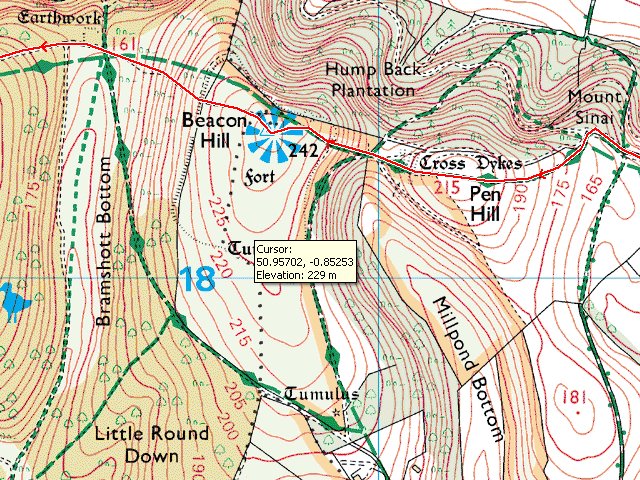
Down to Queen Elizabeth Country Park, and I softened the climb up Butser Hill by telling myself there were only 2 more big climbs to Winchester. I had a boost near Old Winchester Hill – the original schedule Neil had done for me was for the new bridleway route through Exton, which is at least 20 minutes longer than the classic route through Warnford. I’d made a last minute decision to go for the classic route, and had revised my schedule slightly, but as it turned out, not enough. The elasticity in my schedule meant that I hit Warnford only 6 minutes behind my original schedule, knowing that I’d get a similar time bonus on the way back. Winchester was inching nearer and nearer – I was definitely going to make it. A minor blip as I attempted to take my Camelbak off and extricate a sandwich as I climbed the hill towards Cheesefoot Head to save time – only to lose far more time as my GPS logger fell to the ground, necessitating me retracing my steps. When I picked it up the green light indicating a signal was being received was showing a continuous red, which I remembered from the manual indicated a fault. Unsure what else to do I took the batteries out and put them in again – to my relief after a few moments the green light flashed again. I decided to stop to take out food in future.
Turn around at Winchester
As I rode into the centre of Winchester, I was a bit freaked out after 7 and a half hours of riding in almost total isolation to be surrounded by traffic , shoppers and office workers enjoying an Indian summer’s day in town. I sat down by King Alfred’s statue at 1.44pm, 5 minutes ahead of my original schedule, having made up the puncture time loss and my later than planned start. 80 miles in, I was tired but not ready to give in – surely cutting an incongruous figure coated in sweat and grime sucking on an energy gel among the well-heeled of Winchester. But I didn’t care. I was going to turn round and carry on riding.
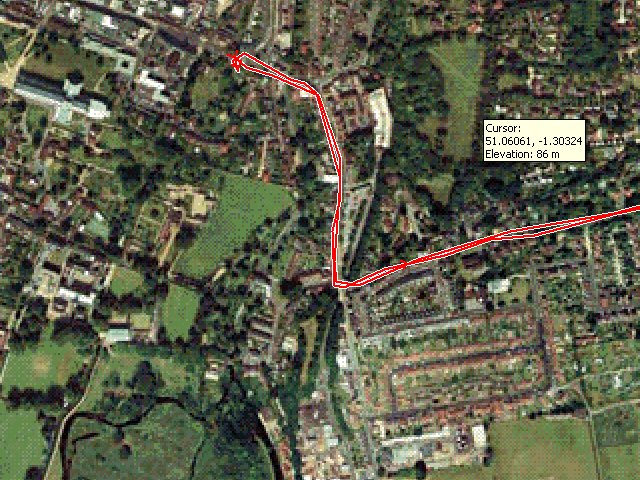
The afternoon went pretty well. I wasn’t getting much tireder, my knee wasn’t getting much worse, and I was eating into my schedule. 33 minutes ahead at QECP thanks to my Warnford bonus. 36 minutes ahead at Cocking, where at last I was able to refill with water. I’d ridden 70 miles in the heat of the day without access to a tap, and had been riding dry for miles, so that was a boost. Afternoon merged into evening, and as I crested the hill into Amberley dusk was falling and so was the temperature. I stopped at Amberley Bridge 39 minutes ahead of schedule, pulled on the thin Pertex jacket which was my only additional item of clothing, and mentally prepared myself for the dark. I’d ridden 125 miles, further than I’d ever ridden before, but I still had 75 to go in darkness. I was carrying a piggy-back cell for my main light, but I reckoned I only had about 10 hours of battery life. It was 7pm, and my 24 hours would be up at 6am. I had to hope that I could stay reasonably close to my target time of 22 hours or I would risk running out of light.
Darkness falls – with a long way to go
I climbed out of Amberley, and within half an hour it was completely dark. It’s hard to convey to people who aren’t familiar with off road riding how much concentration it takes to ride for 24 hours on a trail like the South Downs Way. The surface is constantly changing, as is the incline, you can’t really switch off for a moment, you’re always looking for the best line for your wheel, alert to potholes, roots, grooves that will trap your tyre, sharp flints that could give you a puncture, gravel or wet chalk that could send you sprawling. Always trying to push the pace to the max but not go into the red zone or wipe out. Then there’s staying on the route, being aware of where you are and where the tricky turns are. Keeping yourself going mentally, coping with the tiredness and physical niggles. Remembering to eat and drink, planning what you’ll need out of your backpack next. It’s intense, hour after hour after hour, and when it gets dark, it’s even more demanding. Some endurance riders swear by their iPods – I brought mine along for the ride, but never felt like using it – just didn’t have the head space for banging tunes.
This was really the first proper night riding I’d ever done and I was a bit worried about how much slower I’d be and how I’d cope – but the lights were so good I didn’t have to slow down at all. Every bump was sharply illuminated. It took massive concentration, but I could really hammer the descents – total focus, but total exhilaration, and the extra attention took kept my mind off how my body was feeling. Within a few miles I was completely relaxed about riding in the dark. Everything started to get more familiar – I know the section from Amberley to Eastbourne pretty well, and even the hills felt like old friends. I was homeward bound – every pedal stroke took me closer. I relaxed into the dark, and enjoyed the odd startled flap or scuttle as I disturbed the peace of the human-free night. My night wildlife count (excluding sheep): 2 owls, 1 badger, 2 stoats, 1 fox, and 75,000 suicidal rabbits. How I didn’t kill one I’ll never know.
Schedule slippage
I got a further boost when a running and cycling friend Simon Thomas texted me and said he was going to come out and meet me at the A27 crossing near Lewes. That really gave me something to aim for – my first friendly face in over 16 hours of riding. I kept pushing hard, but was no longer gaining on my schedule – if anything I was losing time, and by the time I met up with Simon at 10.40pm near Lewes I was only 10 minutes ahead – 10 minutes which I lost chatting and posing for pictures. Well worth it though for the boost to my morale. And I’d made it to Lewes – job almost done, surely?
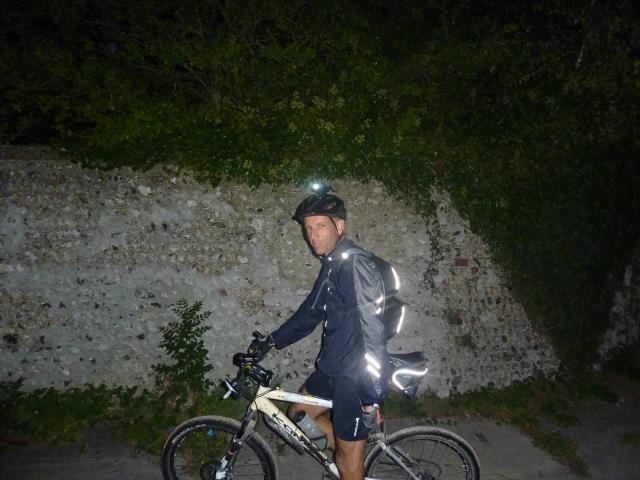
Well no actually, far from it. As I climbed up Kingston Ridge, I started to feel really really weary, tireder than I can ever recall feeling. I realised I had barely even thought about the final 45 miles. I started to remember that this was actually the toughest section of the whole route – the climbs are massive and they just keep coming. I kept pushing hard, but my pace on the hills slowed to little more than a walk, and having been well ahead of schedule for hours, I was suddenly falling behind, yawning uncontrollably, and losing minutes more at every time check. By Firle Beacon I was 15 minutes behind schedule.
Lost in the dark and the fog
Then disaster struck. Riding along the ridge towards Alfriston, I was suddenly in dense fog. I could see no more than 5 feet, and my lights bounced off the fog, blinding me. It seemed inconceivable that I could lose my way on a section of the Downs I know like the back of my hand and which is so open, but there are long stretches of this section which are just sheep-cropped grass with nothing on the ground to follow. In the dark and fog, I just couldn’t stay on the track, and just past Bo Peep I found myself on a totally unfamiliar path going downhill when I knew I should be on the flat. In panic I retraced my steps and found the right track again, but minutes later I was again off the path , riding along a fence through dense fog with no idea of where the path was. I tried to visualise the ground, and luckily chose the right direction. A few minutes later I was back on the path again. But by the time I hit Alfriston, I was 25 minutes behind schedule.
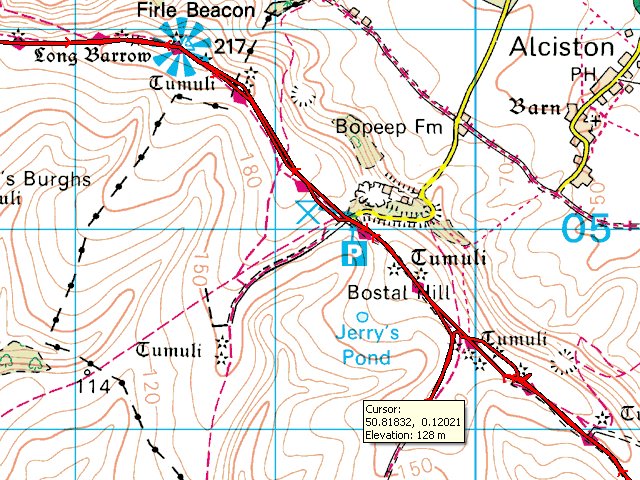
Eastbourne – and the second turn
The climb out of Alfriston is a monster, and my progress was painfully slow. I hit more fog at the top of Windover Hill, and again lost the path. Exhausted, I crawled up the climb from Jevington, out of the saddle continuously to try give my knee a break. At last I crested the ridge above Eastbourne, and the lights of the town were a truly beautiful and most welcome sight. I was a bit worried about finding the right path off the Downs, but at 1.54am I was standing by the Southdowns Way signpost on the edge of Eastbourne.
But by now I was 45 minutes behind schedule. 22 hours was by now out of reach, but surely I could still make the 24 hour time limit – couldn’t I? Just over 4 hours to make it back to Lewes – 25 miles, surely I must be able to average 6mph even in my dilapidated state? But I had been barely averaging this for the last 10, and I couldn’t afford to get lost in the fog again, while another puncture would surely derail my whole ride. With no time to lose, I turned straight around to start the climb up out of Eastbourne.
Counting down and clock watching
By now I could count down the hills on the fingers of one hand. Mercifully the fog had cleared, and brilliant moonlight illuminated every contour of the sections over Windover Hill and Bo Peep where I had been totally lost a few hours previously. Now my own tyre tracks were as clear as day, leading me home. On I went, through silent streets and past countless sheep, as if I was the only soul alive, the world emptied of people while I continued my lonely odyssey. By now every incline slowed me to a crawl, I was out of the saddle wherever possible to relieve the pain in my knee and backside, and I even had to slow down on the descents, so battered were my arms from the constant jarring and vibration. One last crisis as I again went off track coming down towards Itford Farm – inexplicably I got totally disorientated and ended up off the path on a part of the Downs I didn’t recognise at all. But I managed to figure out a few landmarks, and after only a few minutes lost I was back on track. Another minor delay to answer a much postponed call of nature near Southease, and I was on the home straight, grinding up the Yellow Brick Road. Back over the A27 with an hour to do the climb up to Blackcap, and I knew barring a disaster I’d done it. My eyes were glued to the path for any potential thorns or flints, and I started to think about contingency plans – if I got a puncture now would I just run with the bike? I didn’t fancy my puncture mending ability in this state of exhaustion. But there were no further disasters in store – with mounting and excitement I saw the incline flatten and turned right up the sheep track and through the woods to Blackcap, finishing with a flourish in 23.31.53. I’d done it!
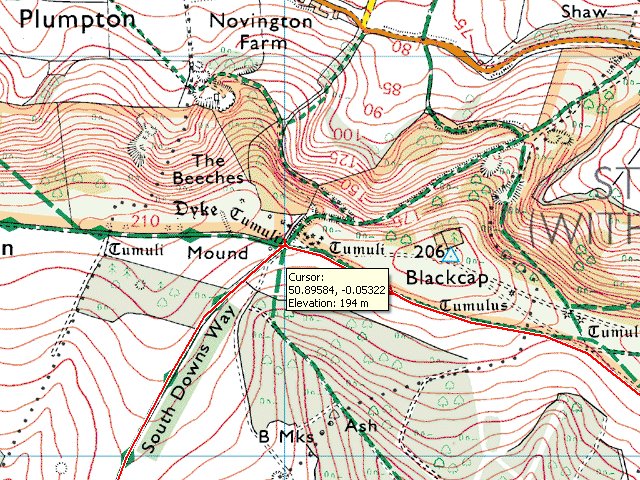
All over exhaustion
It was still pitch black, and the grass was soaking with dew, but I just threw myself to the ground and lay on my back for minutes, eyes shut, groaning loudly, theatrically, but almost without volition or control. I was still self-conscious enough to be quietened by a cough – but my company was 4 legged rather than 2. I sat up, now feeling cold, and with great reluctance got back on the bike, when to be honest I just wanted to throw the bloody thing in a bush. A second later my main bike light gave out – I’d only just made it. The 4 miles back home were just awful – all downhill so generating no heat at all, in the cold of the dawn, soaking with dew and sweat. By the time I hit street lights my teeth were chattering with cold, and only the brisk walk up the hill behind our house brought any relief. Then straight in the bath where I lay in a stupor, barely conscious.
Reflections, and recovery
I’m writing this a month after the ride. I’d say I’m only just recovered from it, physically and psychologically. It doesn’t take much to muck up my body clock – it took days for my sleep to recover. My knee is still not right – although I am running again. 10 days after the ride I had an England orienteering race, which I just about got through with intensive physio and taping my knee. But my energy has felt depleted for the last 4 weeks, and is only just coming back now. I lost half a stone on the ride, and that’s still not come back. My piles are only just receding. My back and shoulders have been sore ever since, despite 6 osteopathic treatments. But as much as the physical impact, it’s taken a lot of psychological processing. I was quite overwhelmed by the comments and good wishes from friends I got in the immediate aftermath of the ride. A huge thing for me, impressive to some, impossible to imagine for most. The nature of the challenge is hard to relate to for people who don’t ride bikes. 100 miles or 200, for most people either is just shorthand for ‘a long way’, and so the difference between riding the South Downs Way one way and the Double can be hard to grasp. At a certain point the numbers become meaningless and disconnected from reality in most people’s minds. Perhaps partly because it’s been hard to convey the experience to others in any kind of meaningful way, the whole thing has been quite hard to process and get into perspective for myself. Work commitments have made it hard to find time to write about the ride in the detail that I needed to get it out of my system until now. To do that ride with such minimal preparation and training is not something I’d advise anyone to contemplate. But pulling it off, against the odds, has taken my view of what I can achieve through sheer willpower and grit, to another level.
When I tell people about the ride and how tough it was, a common reaction is “Didn’t you ever think ‘why am I doing this?'”. The truth is, that thought never crossed my mind. I always knew exactly why I was doing it. Number one, I know that once an idea has got into my head like that, I’ll always regret it if I don’t have a go and see whether I can do it. Number two, I want more from life than the daily routine of family and work commitments, however enjoyable and enriching they can be. When I look back on my life at age 80, there will be some things that stand out as landmark achievements I can be proud of, and this is one of them. Number three, as my running mate Matt Bradford put it, “there can’t be too many things in the world that only 12 people have done”.
The SDD has been in my system for the last 18 months, and having got it out, I’m left feeling overwhelmed by the achievement and the effort it took, but also slightly directionless. For the moment it’s nice to be directionless, but I know it won’t be long before I’m thinking “What next?”
Alans gpx file can be downloaded here
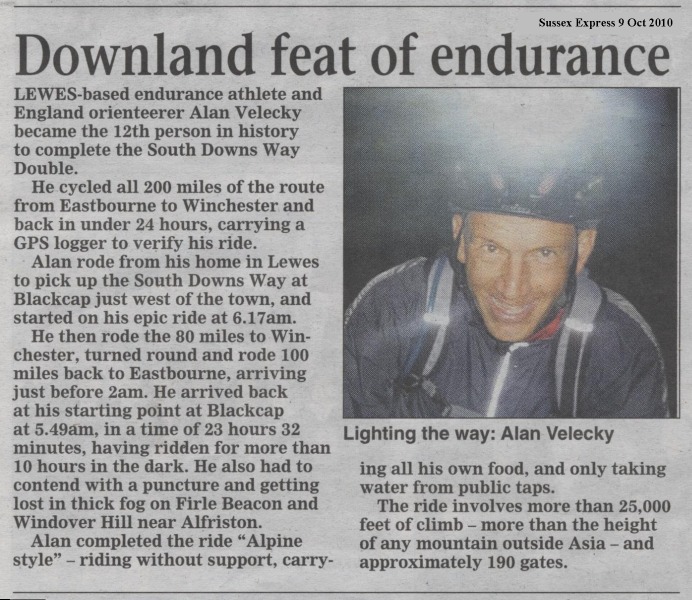

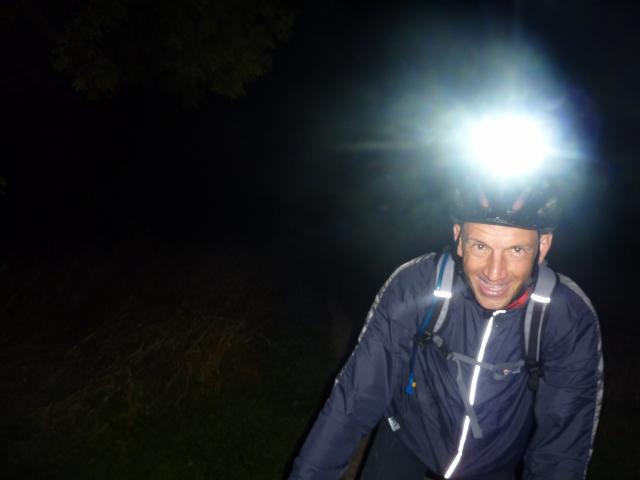
Recent Comments